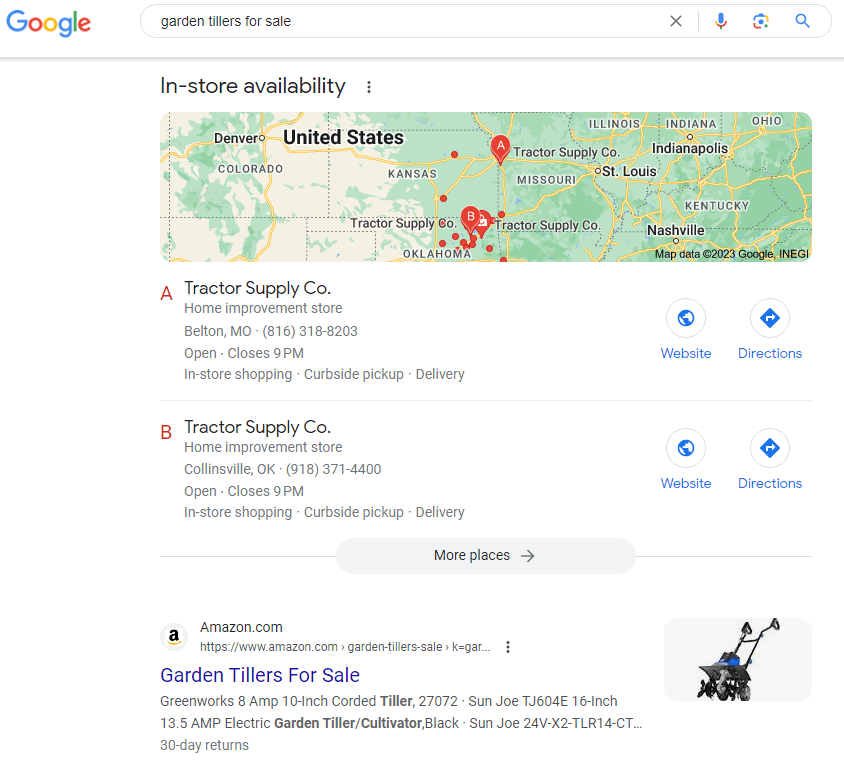- Home
- Blog
- Content Marketing
- 4 Tips for Creating Content That Drives Sales
4 Tips for Creating Content That Drives Sales
-
 Published: May 31, 2023
Published: May 31, 2023
-
 7 min. read
7 min. read
-
 Rendell Weaver
Rendell Weaver Content Writer
Content Writer
- Rendell is an Internet Marketing Consultant at WebFX and a subject matter expert in content marketing, keyword research, and strategic business consulting. Rendell has worked with hundreds of clients to align marketing strategies with business goals and drive revenue. Outside of work, Rendell enjoys working in the garden, board games, and spending time with family and friends.
Looking for top tips for creating content that drives sales and revenue? Then this page is for you!
Using content as a method to drive sales is not a new tactic. But it certainly has increased in popularity with the Internet, search engines, and a shift in how people shop for products and services in the past few decades.
Many companies make creating content a core part of their marketing strategy to take advantage of this opportunity.
There are a number of benefits of content marketing, including the fact that:
- Content can increase the number of leads or sales a business receives.
- Content can increase the quality of leads or increase the value of sales.
It’s important to note that content in and of itself does not naturally drive sales. Like many things, content marketing needs a strategy behind it to maximize effectiveness.
That’s why, on this page, we’re diving into our top content creation tips to help make your content a success.
Let’s dive in!
Don’t miss our Marketing Manager Insider emails!
Join 200K smart marketers for the hottest marketing news and insights in your inbox.
Inline Subscription Form
“*” indicates required fields


Top 4 tips for creating content that drives sales in 2025
Here are our top four content creation tips of 2025:
- Know your audience
- Keep your buyer’s journey in mind
- Be the answer to the questions your audience is asking
- Understand where your audience goes for information
1. Know your audience
First and foremost, you must know your audience and write content geared toward that audience.
Marketing is generally more effective (and drives a better return on investment (ROI)) when you’re doing it with a clear understanding of who your audience is — content marketing is no different.
Most businesses have a good idea of who their general target market is, but knowing how to create content that resonates with your target market may involve digging deeper.
You may be able to understand your audience better by asking questions like these:
- What are the specific job titles of the people you are trying to reach?
- How many personas/consumer profiles do you typically sell to, and what do they look like?
- What are your customer’s motives?
- What are the questions they have throughout the sales process?
A number of tools can be used to gather answers to these types of questions. You can start with their internal team, customer data, website analytics, or customer interviews.

For example, tools like Google Analytics and RevenueCloudFX give you valuable insights into your audience’s interests and demographics.
2. Keep your buyer’s journey in mind
Once you understand who your audience is, create a plan for targeting them at multiple points across the buyer’s journey. Understanding the steps your potential customers take before they make a purchase will help guide your strategy.
A buyer’s journey will look different for every business, but there are typically four main phases:
- Awareness
- Interest
- Desire
- Action
A great content marketing strategy will hit all four of these phases. The goal is to create a mix of content that can get in front of the user at each phase.
Here are a few questions to ask yourself to better understand your buyer’s journey:
- What questions are they asking?
- Where do they go when looking for information?
- Where do they go when shopping for your product or service?
The answers to these questions will direct your content marketing strategy. Let’s walk through these questions with an example.
3. Be the answer to the questions your audience is asking
Let’s say you work for a business that sells garden tools.
There are a number of questions that gardeners will have, and being the answer to those questions will set your business apart as a trustworthy source of garden information. Indirectly, and sometimes directly, this will lead to more online sales for your garden tools.
One question that might get asked by someone new to gardening is: “How do you till up a garden?” As a business that sells garden tools, this is a great question to answer and get in front of your target audience.

Why, you might ask? It gets in front of your audience at the very beginning of their buying journey. This awareness is an important first step in their journey deeper into the marketing funnel.
Businesses can answer commonly asked questions in a number of ways. Here are a few common ways:
- Blog posts
- FAQ webpage
- Social media posts/engagement
- Infographic
It’s important to note that it’s not simply about putting an answer out there but, more importantly, ensuring it gets in front of your target audience.
Which leads us to our next tip.
4. Understand where your audience goes for information
Having an answer isn’t going to drive sales unless it’s getting in front of your target audience.
Whether you create a blog post, infographic, or video, you’ll want to ensure your content is optimized and well-distributed.
Search engine optimization (SEO)
In the age of the Internet, most people go to a search engine to find answers to their questions. Optimizing your website to show up as the answer to their questions, and specifically for a product or service they search for, is one of the most effective ways to drive sales with your content.
Content marketing is a core part of an SEO strategy, so it’s important that your content aligns with the search queries that your potential customers are searching.
Distribution
There are many channels to distribute your content.
For example, a blog post could be re-purposed as needed on the Internet as:
- A video
- A social media post
- A graphic
- An email blast
Paid ads
Content can also be used to supplement any paid ads campaign.
Ad copy, creatives, landing pages, etc., can all be enhanced by re-purposing content from your content marketing efforts.
For example, your main goal with an ad might be to drive a lead, a quote, or to book an appointment. To help appeal your landing page appeal to more users than just users who are ready to take the next step, you might outline what sets you apart from the competition with an infographic or a PDF guide for download.
How does this help drive sales?
Up until now, we’ve been looking at tips for creating content when your audience is in the early stages of their buying journey.
All of these tactics will support your sales indirectly. According to the rule of seven, it typically takes seven touchpoints before a potential customer turns into a sale. For this reason, the content you created early in the buyer’s journey contributes to driving sales down the road.
Content also plays a pivotal role in driving sales directly from users who may be searching directly for your product. In other words, these users would be at the bottom of the funnel and ready to make a purchase.
To use the garden tools company example, if someone is ready to purchase a tiller for their garden, they would likely be searching something like “garden tillers for sale” on a search engine.

Ranking for these bottom-of-the-funnel keywords is generally more difficult than informational keywords, but the value of traffic is much higher. Businesses can use content to target these transactional keywords by optimizing product, category, or brand pages.
A major benefit of a full-funnel approach to marketing is that all content on your website can feed into the same goal of driving sales. With a solid SEO strategy, search engines recognize the authority you have due to all your content across the buyer’s journey and will rank your revenue-driving pages accordingly.
Our digital marketing campaigns impact the metrics that improve your bottom line.
See Our Approach
$10 billion

24 million

7.14 million
Ready to start creating content that drives sales?
WebFX is an expert in content marketing for companies of all sizes. With over 500 digital marketing experts and content creators, our team can help drive revenue with content marketing on your website.
Request a proposal to get started today.
-
 Rendell is an Internet Marketing Consultant at WebFX and a subject matter expert in content marketing, keyword research, and strategic business consulting. Rendell has worked with hundreds of clients to align marketing strategies with business goals and drive revenue. Outside of work, Rendell enjoys working in the garden, board games, and spending time with family and friends.
Rendell is an Internet Marketing Consultant at WebFX and a subject matter expert in content marketing, keyword research, and strategic business consulting. Rendell has worked with hundreds of clients to align marketing strategies with business goals and drive revenue. Outside of work, Rendell enjoys working in the garden, board games, and spending time with family and friends. -

WebFX is a full-service marketing agency with 1,100+ client reviews and a 4.9-star rating on Clutch! Find out how our expert team and revenue-accelerating tech can drive results for you! Learn more
Try our free Marketing Calculator
Craft a tailored online marketing strategy! Utilize our free Internet marketing calculator for a custom plan based on your location, reach, timeframe, and budget.
Plan Your Marketing Budget

Looking for More?
Get expert ideas, industry updates, case studies, and more straight to your inbox to help you level up and get ahead.
"*" indicates required fields

Proven Marketing Strategies
Try our free Marketing Calculator
Craft a tailored online marketing strategy! Utilize our free Internet marketing calculator for a custom plan based on your location, reach, timeframe, and budget.
Plan Your Marketing Budget
What to read next





